EISLEBEN, GERMANY - I struggle to get to the top of a hill where historic St. Anne’s Church stands and by the time I reach the summit I’m left breathless - by the stunning panoramic view I’m getting of the old mining town that sits cradled between the rolling Harz Mountains and the slow moving River Elbe.
The orange tiled roofs of the town’s neatly-kept homes stand out against a gloomy sky and a number of impressive church steeples stick up like pins on a giant map - they would later mark my way to the places where Eisleben’s most famous son Martin Luther was born, preached and eventually died.
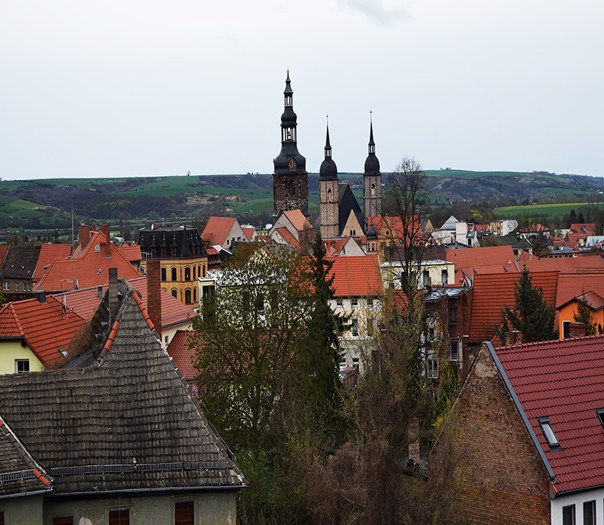
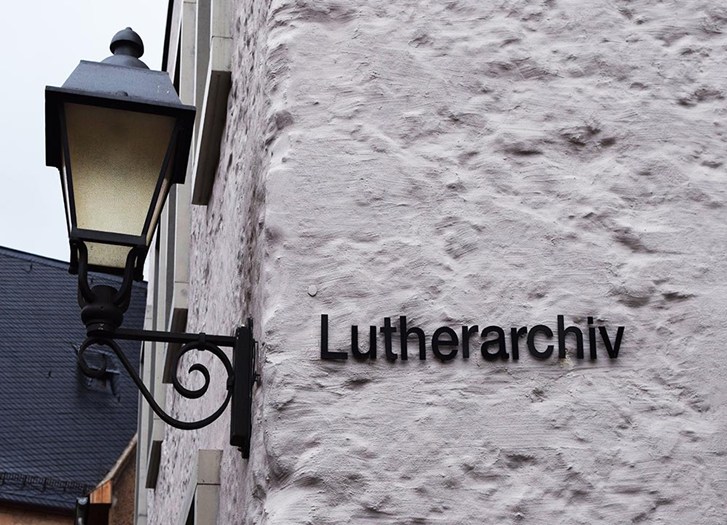
Left: Eisleben was once a rich mining town. Right: Street named after Luther.
An early morning drizzle forces me to take refuge in what’s also known as the Miner’s Church - St. Anne, for whom the church honours, is the patron saint of miners and the reason Luther first became a monk long before launching his Protestant Reformation. (The story goes: Caught in a violent thunderstorm in nearby Erfurt, Luther, who feared for his life, apparently prayed to St. Anne and promised to become a monk if she spared him. The rest, as they say, is history.)
Once inside the ancient church - circa early 1500s - I’m impressed by its stunning coffered ceiling, elaborate pulpit and the unique “stone bible” arranged around the main alter.
Curious, I ask a woman cleaning the pews if she could explain how the 39 stone tablets that sit in front of choir stalls came to be.
“The miners could not read or write in the Middle Ages so Countess Margarete (her family ruled this area back then from a castle in nearby Mansfeld) commissioned the stone bible in 1585 so the miners could learn all about the Old Testament,” she tells me.
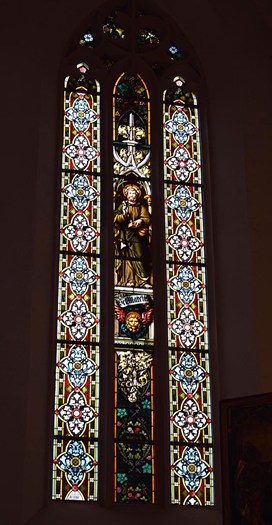
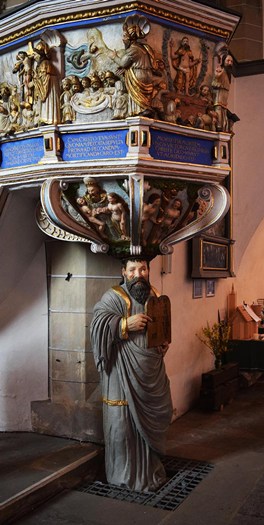
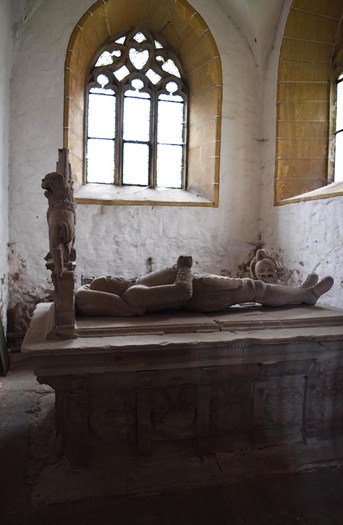
Above: Eisleben is full of beautiful, historic churches.
The woman then reveals the picturesque gabled homes that sit alongside the church once housed Augustinian monks, the same order Luther entered after being saved in the thunderstorm.
“After the Reformation, though, Luther expelled the monks, many of whom were his friends,” says the lady, who adds, “while St. Anne’s was the first church in this area to embrace the Protestant movement, there is no record of Luther ever preaching here.”
Luther has left his mark on a lot of other places in Eisleben, though. And now that the rain has stopped, I trudge down the steep hill from St. Anne’s and a short time later find myself staring at a bronze statue of Luther in the town’s medieval Market Square, where there’s a beehive of activity - workmen are busy getting the square ready for the 500th anniversary of Luther’s Protestant Reformation, which will be celebrated throughout Germany, and especially here, in 2017.
Luther was born a short walk away from Market Square on November 10, 1483 in a house that was later consumed by fire. Luther’s followers erected a museum on the spot where he was born in 1693 - making it one of the oldest museums in the world - and Protestants from around the globe come to pay their respects. A group of Koreans asks me to take their picture in front of the museum, which is filled with artefacts from Luther’s time.
The street beside the house leads me to the Church of St. Peter and St. Paul, the place where Luther was baptized a Catholic on St. Martin’s Day, the day after he was born.
“That’s why they called him Martin,” says a guide in the church, who also tells me Luther’s family name at the time of his birth was actually “Luder.”
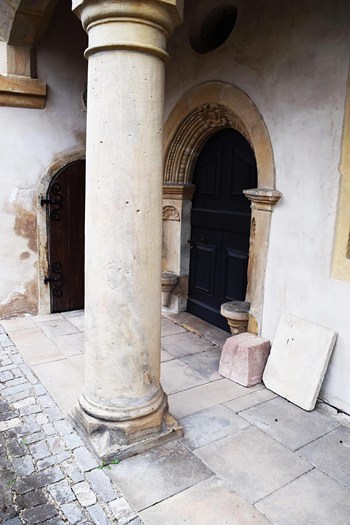
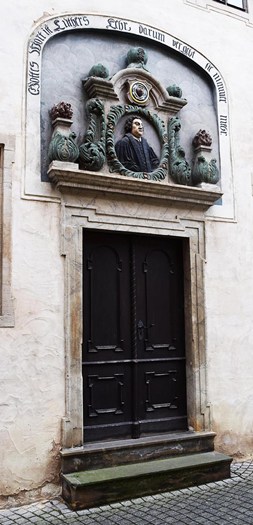
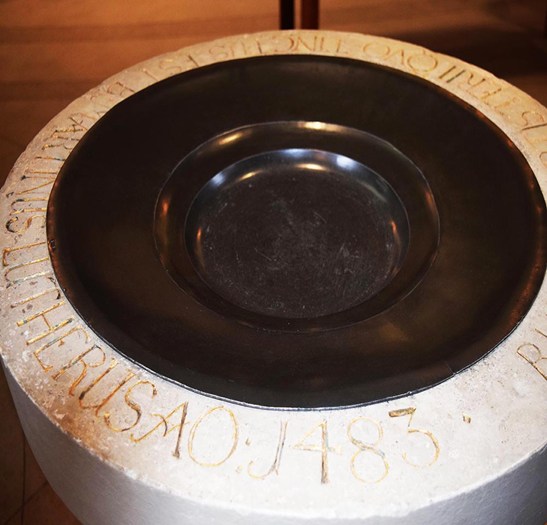
Left: Birth house Centre Luther museum. Right: His baptismal font.
“He changed it to Luther in 1517 at the height of the Reformation,” the guide says.
The vast Gothic-style church with the lovely winged alter (circa 15th century) and fan vault, reflects Eisleben’s one time wealth - the hills around this charming mining town yielded much copper and silver during its prime and the rich townsfolk spared no expense building this handsome church, which actually dates back to 1333.
The one item that attracts most Protestants to St. Peter and St. Paul, though, is the actual baptismal font in which Luther was baptized. The font was lost for many years but in 1726 it was unearthed in a local garden and brought to the church.
“Many people like to touch the font and believe it brings them inspiration,” says the guide.
Because there’s so much in Eisleben that’s connected to Luther and the Reformation, the town was given UNESCO World Heritage status in 1997.
One of the sites that’s most intriguing is Marktkirche St. Andreas (the Church of St. Andrew) where Luther frequently preached when he visited his hometown. In fact, St. Andrew was where he preached his last four sermons before he died on February 18, 1546.
Also known as Market Church because of its close proximity to the main square, St. Andrew was originally built as a Romanesque building but was almost totally destroyed in a 15th century fire and was then rebuilt to create a rare triple nave hall church. St. Andrew, which has been described as a “stern looking Gothic hall church,” is much different then St. Peter and St. Paul - the dimly lit structure which needs much work after years of neglect under East Germany’s communist rulers, features the tomb of Count Hoyer VI, a member of the House of Mansfeld. The pulpit from which Luther preached also remains - preserved in a glass case on the south wall.
In the final days of his life, Luther established a Latin school for boys and girls - a rarity for the times - beside St. Andrew and that school still exists today.
Across the street from St. Andrew is the house first believed to be the place where the Great Reformer died. However, years after the house was transformed into the main Luther Museum and recognized as a UNESCO World Heritage Site, it was determined it had been misidentified as the death house. Oops.
Still, it remains a museum and is crammed with lots of Luther memorabilia, including the wooden coffin that transported his body back to Wittenberg, where he now lies entombed in Castle Church.
The museum is also filled with lots of mining history - Luther’s father was a miner leaseholder of copper mines and smelters - and reminds us that Luther not only reformed religion in Germany but he also reformed the school system and taught many to read and write. He reportedly said: “what good is it for me to translate the bible to German if no German can read it.” He was also a big proponent of educating girls, something unheard of back in the 14th century.
A large painting on the top floor of the museum freezes on canvas the moment just before Luther’s death, which apparently resulted from a massive heart attack a few days earlier. Luther is surrounded by family, friends and the Duke of Mansfeld and just before he died he apparently looked skyward and said: “take my little soul to You.”
Now, many souls come to Eisleben to honour him.
Information
Eisleben is located in the German state of Saxony-Anhalt. / The official name of the town is Lutherstadt Eisleben, population 24,552. / Eisleben is divided into old and new towns (Altstadt and Neustadt); the latter was created for Eisleben's miners in the 14th century. / Eisleben was first mentioned in 997 as a market called Islebia and in 1180 as a town. / On June 6, 1927, American aviator Clarence D. Chamberlin landed outside the town in a wheat field, completing the first transatlantic passenger flight (Charles Albert Levine was the passenger), and breaking Charles Lindbergh's distance record that Lindbergh had set only two weeks earlier when he landed in Paris. / The best way to get to Germany from Canada is with Lufthansa via Frankfurt or Berlin. Air Canada also offers daily service to Frankfurt. / For tourist information on Germany, go to
http://www.germany.travel